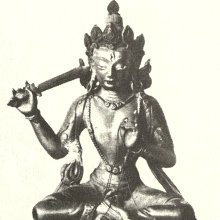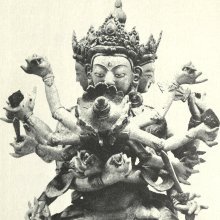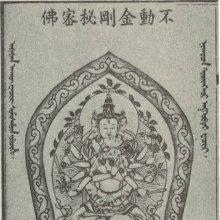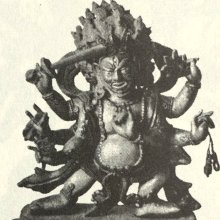Akshobhyavajra, Akṣobhyavajra: 1 definition
Introduction:
Akshobhyavajra means something in Buddhism, Pali. If you want to know the exact meaning, history, etymology or English translation of this term then check out the descriptions on this page. Add your comment or reference to a book if you want to contribute to this summary article.
The Sanskrit term Akṣobhyavajra can be transliterated into English as Aksobhyavajra or Akshobhyavajra, using the IAST transliteration scheme (?).
Images (photo gallery)
In Buddhism
Tibetan Buddhism (Vajrayana or tantric Buddhism)
Source: Wisdomlib Libary: VajrayoginiAkṣobhyavajra (अक्षोभ्यवज्र) is the name of a deity to be contemplated upon by a practicioner purifying his correspondences (viśuddhi), according to the 12th-century Abhisamayamañjarī. Akṣobhyavajra is alternatively known by the name (Śrī) Herukavajra. The contemplation is prescribed as a preliminary ritual for a yogin wishing to establish, or reestablish the union with a deity.
Akṣobhyavajra is associated with the skandha named tathatā (suchness) and the color black. He is to be visualised as standing in the warrior (ālīḍha) stance, having three eyes, matted locks and bearing the five signs of observance (mudrā).

Tibetan Buddhism includes schools such as Nyingma, Kadampa, Kagyu and Gelug. Their primary canon of literature is divided in two broad categories: The Kangyur, which consists of Buddha’s words, and the Tengyur, which includes commentaries from various sources. Esotericism and tantra techniques (vajrayāna) are collected indepently.
See also (Relevant definitions)
Full-text: Herukavajra.
Relevant text
Search found 1 books and stories containing Akshobhyavajra, Akṣobhyavajra, Aksobhyavajra; (plurals include: Akshobhyavajras, Akṣobhyavajras, Aksobhyavajras). You can also click to the full overview containing English textual excerpts. Below are direct links for the most relevant articles:
Blue Annals (deb-ther sngon-po) (by George N. Roerich)
Chapter 29 - Sonam Gyatso (iii): Ordination and early education < [Book 10 - The Kālacakra]
Related products



